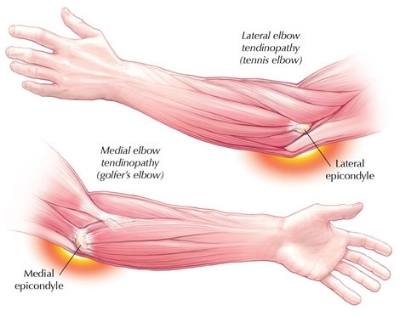Overuse Injuries in CrossFit
With any high level activity or sport
there is risk of injury.
I recently had a conversation with someone discussing the “risks” of CrossFit and the safety of the sport. I don’t want to start a huge debate here, but I often see more serious injuries in the clinic associated with other sports like soccer, mountain biking, or skiing, than I do from CrossFit. Personally, I have had less injuries since I started CrossFit, and the ones I have had happened from activities outside the gym!
That being said, injuries do happen, and the injuries I see the most often in CrossFitters tend to be from overuse.
First let’s talk about the different types of injuries.
Acute: a single traumatic event
examples: wrist fracture, shoulder dislocation,
sprained ankle, hamstring strainusually obvious
Overuse: REPETITIVE microtrauma over time
Bone (stress fracture, stress reaction)
Tendon (tendinopathy)
Joint (degeneration, labrum injuries)
Muscle/fascia - (Delayed Onset Muscle Soreness/DOMS, fasciitis)
Bursa (bursitis)
Ligament (chronic degeneration, micro-tears)
Nerve (irritation, neuropathy, entrapment)
Without going into too much detail, the human body has the ability to adapt to physical stress through a process called remodeling (tissue thickens, muscles and tendons get stronger, bone density improves).
This is how we build muscle and make GAINS!
However, with excessive and repeated use of the same muscle, bone or joint, breakdown of tissue happens more than it can build and remodel, resulting in tissue INJURY.
So what are overuse injuries?
Overuse injuries occur when the the tissue (muscle, tendon, bone) is unable to adapt to the demands placed upon it. Over time this causes microscopic injuries/microtrauma to the tissues.
Example: Say you dropped a heavy barbell on you foot. It would probably hurt and you would expect to have a big bruise the next day. That’s obvious. But have you ever woken up the next day after a WOD involving high rep hang cleans and noticed bruises on your thighs? Well the bar probably didn’t hurt as you were bouncing it off your thighs during the workout, but because of the high number of times you did it, it created a bruise….repetitive trauma.
This is similar to what happens with overuse injuries. There is usually not one specific instance in which you felt pain or “trauma,” but maybe you woke up the next day with pain or increased soreness that didn’t go away.
Over time the tissue can not keep up with the demands being placed UPON it.
Common overuse injuries in CrossFit:
(Look for more posts in the future wth details on some of the conditions listed!)
Achilles tendinosis
Rotator cuff tendinosis/shoulder impingement
Plantar fasciitis
Anterior knee pain
Patellofemoral pain
Runner’s knee
Jumper’s knee
Shin splints
Hip impingement
Wrist pain
Low back pain
All of these can lead to more serious injuries, such as muscle strains, muscle and tendon tears, or disc herniations if there continues to be repetitive trauma.
What does it feel like?
Symptoms may begin with discomfort in the morning or before warming up. They can progress to discomfort or pain during the warm-up and after activity, and can worsen to pain during activity and all the time.
Symptoms may include:
stiffness
soreness
redness
swelling
warmth
dull, achy pain
sharp pain
tenderness
cramping
pins and needles
What causes or contributes to overuse injuries?
Improper training “too much, too soon”
rapid acceleration of intensity, duration or frequency of activity
performing new movements
Lack of recovery/rest
poor nutrition, hydration, sleep, increased stress
Too much rest then returning to previous level of activity too quickly
Previous injury
Technique errors, poor mechanics
Lack of muscle strength and/or endurance
Muscle imbalances
Mobility/flexibility restrictions
Biomechanical issues (flat feet, scoliosis)
Core weakness
What does this have to do with Crossfit?
I'm glad you asked...
Not all overuse injuries happen from CrossFit, however CrossFit involves new activities and skills that people haven’t typically done before (ring muscle-ups, kipping pull-ups, overhead squats, box jumps, etc.), performed at high reps and at a high intensity. Combine this with poor technique, lack of recovery and some muscle imbalances...well there you have it.
Don't Worry!
You can reduce your risk of overuse injurY by doing the following:
1. Take a look at your training program. Hopefully your box does a good job with their programming by varying the movements and the rep scheme over time. However, it's not all on them. Yes, it's CrossFit and we want you to workout at a high intensity, BUT if you are working out multiple times per week, you shouldn't be going 100% on every workout. Pick a couple of workouts each week to go "all out" on, perform another WOD at moderate intensity around 80%, and then 1-2 WODS at 60-70%. Not only does this give your body time to recover (which it needs to get stronger!), but it also gives you a chance to focus on technique with lower intensity, lighter weights, and more control.
2. Recover properly. This means making sure you are eating well, hydrating, getting a full night's sleep, and managing your stress levels, Get body work done like ART or massage therapy and/or perform self soft tissue mobilization with a foam roller or lacrosse ball. Also stay consistent with any physical therapy home exercises or movement correctives you've been given. And don't forget to do a proper warm-up and cool-down for each workout!
3. Listen to your body. If something doesn't feel right, get it checked out! The longer it goes on the more difficult it can be to treat.
Schedule an appointment
with us and we can help you get control over it early!
Contact us to learn more about how we treat
overuse injuries
Written by Beth Ansley, PT, DPT, OCS
For questions contact me at beth@arrowptseattle.com
















